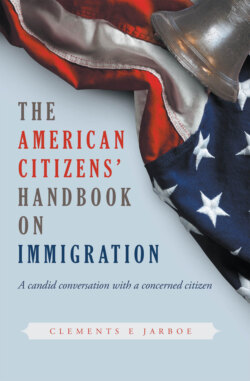Читать книгу THE American Citizens Handbook on Immigration - Clements Jarboe - Страница 8
На сайте Литреса книга снята с продажи.
ОглавлениеChapter 2
So Where Are We Today, and Where Do We Go from Here?
“In approaching immigration reform, I believe that we must enact tough, practical reforms… We need stronger enforcement on the border and at the workplace… But for reform to work, we also must respond to what pulls people to America… The time to fix our broken immigration system is now.”
—Barack Obama (quote from 2008 campaign website)
Illegal migration, how do you measure something that, for the most part, has no concrete numbers? It is rather a subset of another larger number—all immigration.
From 2010 through 2017, the immigration population (legal and illegal) has grown from 40 million to 44.5 million, or an 11.5 percent increase.
According to Pew Research Center 2016 estimates, there were 34.4 million lawful immigrants, 10.7 million illegal immigrants, and 2.1 million temporary lawful residents.
The Center of Immigration studies put a record 44.5 million in the country by 2017, counting both legal and illegal, and that number shows that one of seven US residents are immigrants, the highest percentage since 1910.
The Migration Policy Institute shows 43.7 million immigrants by 2016, with 11.5 million being illegal. Also, one-fifth of the entire world’s immigrants lived in the US in 2017.
The Center for American Progress professes that today, there are 43.3 million immigrants in the country, with 11.1 million illegal immigrants aboard and 1.7 million with temporary visas.
With all that said, see disclaimer below from one of the institutes.
Note: MPI is among a small number of organizations that generate estimates of the unauthorized population because the Census Bureau does not. It is important to acknowledge that the estimates issued by MPI and others (including the DHS Office of Immigration Statistics, Pew Research Center, and Center for Migration Studies of New York) are based on different methodologies and data sources. Hence, the estimates are not fully comparable.
Then in November of 2018, a report from Yale University School of Management shocked the arena with a new extrapolation of the data showing that in actuality, there are twenty-two million illegal immigrants residing in the US.
As the summary of their report stated, “After running 1,000,000 simulations of the model, the researchers’ 95% probability range is 16 million to 29 million, with 22.1 million as the mean.”
According to the United States Border Patrol statistics, there were 3,070,068 illegal immigration apprehensions on the Southwestern border from 2010 to 2017. That’s an average of 31,979 a month during that time.
On Thursday, 21st of February 2019, Steve Camerota, research director for the Center of Immigration Studies, stated, “A half-million new people settle illegally in the United States each year, marking numbers that are roughly equivalent to the population of Atlanta.”
“The five hundred thousand figure doesn’t necessarily mean the border,” Camerota told Fox News’s Fox & Friends. “That can include people that overstay a visa. At minimum, 200,000 and more are expected to do it this year successfully, illegally cross the border between the ports of entry.”
There we have it, the parameters of how many illegal immigrants are in this country. So is this a good thing or a bad thing?
For this conversation, we will use Yale’s twenty-two million mean number and two hundred thousand making it across the border yearly according to Steve Camerota.
Earlier, we had mentioned that illegal immigrants were a subset of all immigrants. Well, that subset can be, for the most part, divided into two parts: the illegal immigration faction coming through the porous Southwest border and the more overlooked faction of noncitizens violating their temporary visas.
People from all over the world can obtain temporary visas for numerous reasons, from coming here for a vacation for ninety days(B1-B2) to continuing education(F1, J1, M1). Time of the visa is the length of the program. The big one are the visas for work (H1B, H2B, H, L1, E1, E2, J1, O, P, and R).
More than six hundred thousand foreign travelers who legally entered the United States in 2017 overstayed their visas and remained in the country by the end of the year, according to Department of Homeland Security.
Over the last twenty years, 37 percent of all aliens free pending trial failed to appear for their hearings. From the 2,498,375 foreign nationals outside detention during their court proceedings, 1,219,959 were ordered removed, 75 percent of them (918,098) for failing to appear.
Deportation orders for failure to appear are the largest group of orders issued by immigration courts outside detention facilities.
Among those who absconded from court were 3,095 aliens from the thirty-six countries that promote terrorism.
As populations from countries that promote terrorism have increased since 9/11—from naturalized citizens, immigrants, and refugees—plots and acts of Islam-inspired terrorism have also increased, more than twice as many under Barack Obama than under George W. Bush.
